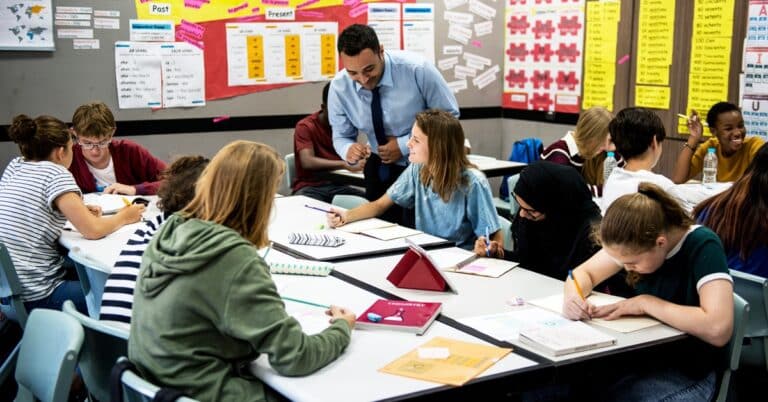 Advanced Placement tests, college placement exams, college finals, MSAT, professional certification exams, etc. We live in a culture of test taking: as students, as adults. The stress levels for adults and students can quickly become overwhelming. We want our students to do well, but the anxiety caused by high stakes tests can have negative results.
Advanced Placement tests, college placement exams, college finals, MSAT, professional certification exams, etc. We live in a culture of test taking: as students, as adults. The stress levels for adults and students can quickly become overwhelming. We want our students to do well, but the anxiety caused by high stakes tests can have negative results.
Here are 10 tips to help students prepare for tests with a little less stress.
Teach and Practice Relaxation Techniques
High stakes testing can make students…adults feel out of control. They are responsible to perform at their best and many are not confident about the material. Teaching and practicing relaxation techniques gives kids back a little bit of control. They start to realize that while they can’t control the test, they can control their personal, physical and psychological reaction to it. The most effective way to build this skill is to start it early in the semester – way before high stakes tests are the biggest concern. Then relaxation becomes a problem solving skill that can be used during tests and as part of their everyday lives. However, it’s never too late to start. Here are three techniques to get started.
- Deep Breathing: Check out this video for help practicing the 4-2-8 method of deep breathing to promote relaxation.
- Teach a stress buster formula of 1 + 3 + 10. Educational psychologist and TODAY contributor Dr. Michele Borba offers a three-step approach that kids can apply when they feel their body getting tense. The “1” is to first stop and tell yourself, “Be calm.” The “3” reminds them to take three deep breaths. Then they should counts slowly to ten inside their head. Borba suggests printing the formula on large pieces of paper to help kids remember it.”2
- Visualization: In an article for adoption.com, Dr. Amie Gordon-Langbein explains how visualization techniques during times of stress can make children feel calmer. Dr. Gordon-Langbein says “It’s very simple, and involves changing your focus from something stressful in the moment to something unrelated to that stressful situation. You can say to a child, “Close your eyes and try to see – in your mind – your own name. Can you spell your name in your mind? Can you spell it backwards? Can you picture what a camel looks like? What does its head look like? How many humps does it have?” And this technique teaches kids how to re-focus their energy, and calm down.”3
If you aren’t comfortable teaching relaxation techniques, invite a counselor, social worker or other professional in your community into your classroom to teach it to you and your students. The most important aspect is practice, practice, practice. The more often teachers practice these techniques with students before tests, quizzes, etc., the more likely students choose to use them when they are feeling stress.
Provide Opportunities to Share Their Concerns.
High stakes tests cause many students anxiety not because they aren’t prepared, but because they are afraid of letting others down, especially their parents and teachers. Teachers can help decrease this type of stress by offering opportunities for students to express their fears and concerns in a safe and healthy way. Beginning about a week or two before testing integrate activities like these into your lessons:
- Write about it: Ask students to journal about their feelings as they prepare for testing. Sometimes, just getting it down on paper can reduce stress. Collect the journal articles and offer stress-reducing suggestions to students when you return their journals.
- Act it out: Give students a chance to act out their stress by role-playing, creating comic strips or writing songs. Include an opportunity for students to research and share stress-busters within their presentations.
Day of Test Stress Busters
If you are proctoring a test or in charge of setting up test proctoring, consider these strategies to help students start the tests with a positive frame of mind.
- Cinnamon or Peppermint: Provide students with cinnamon or peppermint candies (sugar free candies for students with health issues should be available). Many researchers believe the scents of cinnamon and peppermint help stimulate the brain, improving alertness and focus.
- Stretching: Brain research shows that it is important to keep blood flowing freely throughout your body if you want the brain to stay sharp. Consider giving students and staff five minutes of stretching time before the test and during any breaks in testing. Active stretching or jumping jacks can be a quick and fun way to improve circulation and jump-start the brain.
- Have a little fun: Tell a couple jokes or have a couple students tell some jokes to break up the stress.
- Relaxation techniques: Give students a reminder to use those relaxation techniques you have been practicing.
- EAT! Healthy breakfasts and snacks should be available for every student at school before any high stakes tests. Whenever possible, also have some healthy snacks in the rooms where students are testing so they can get a little extra boost if their brains get sluggish.
Part of Getting Ready for the Tests
High stakes tests are a fact of life in education. While we can’t make them go away, we can provide our students with strategies they can use to minimize the negative psychological effects caused by them. The comments I often receive from teachers are “I don’t have time to do this. We have to get them ready for the test.” My response: This is part of getting them ready for the tests and helping them build the resilience skills they need to handle stress as adults.





